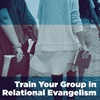I have heard the term "doors" used repeatedly as a metaphor in recent years to describe church outreach. There are "front doors" that we try to get new people to enter. There are "back doors" where visitors and fringe people seem to escape from our congregations never to be seen again. There are even "side doors" that some churches create, intentionally or unintentionally, as pathways for people to come and go. There is lots of thought put into how to make "entry doors" open wider to new people and how to close off "exit doors" where people slip out of church life.
All the discussion and analysis of these symbolic doors is important because reaching people for Christ is one of the most vital things we do as Christ-followers. However, I have noticed most of the "door" metaphors refer to attendance at centralized church events such as weekend worship services. I wondered, what about a small group as an "entry door" to church life?
SmallGroups.com did an informal survey of small group leaders and found that three-quarters of those leaders surveyed said that they had members of their small group that did not attend their church's weekend worship service. That statistic got my attention. I decided to probe a little deeper with a focus group of small group leaders from a broad cross-section of small group and church philosophies.
Here is what I discovered. The average small group size in my sample of small group leaders surveyed was approximately 10 (9.8) people. In those same groups, on average, each group had 1.2 regular group attenders who did not attend their church's weekend worship service. Additionally, on average, each group had 1 (0.93) person who attended their small group "occasionally" but who did not attend their church's weekend worship services. This research indicates that in small groups where the average number of regular attenders is 10 people, it is likely that one of those 10 are "unchurched" (at least by the traditional definition) and another unchurched person attends this same group at least occasionally.
Some Implications
According to The Church Growth Ratio Book (Church Growth Inc.), 5% of a growing church's total weekend attendance should be first-, second- or third-time visitors. Most churches average 1 to 2% visitors. ("Visitor Assimilation"). That means that for every 100 people who attend a church weekend worship service, on average, 1 to 5 of those people will be visitors, or perhaps we could also call them "prospects for further outreach." My research indicates for every 100 people who attend small groups, 10-20 of them are prospects for further outreach.
It is important, however, to make some distinctions at this point. Worship services may still attract more outreach prospects by some measurements because church worship services attract potentially different outreach prospects each week. Of the 10 visitors at this week's worship service, five of them may be completely different people than visited last week's service. On the other hand, in a given small group the one new unchurched person who was invited by a friend to visit the group will probably be the same person who attends next week's group as well. That is a distinction worth exploring further. It has been said that in churches doing a good job with visitor follow-up, the retention rates of visitors run in the range of 1 in 7 down to maybe 1 in 15. That means that of those same 10 visitors in this week's church worship service, you may retain one that will become a regular functioning part of your congregation. While, I have not seen many studies that have quantified visitor retention in small groups, the rates typically are much higher, perhaps 1 in 2. Meaning that for every two new unchurched people who visit your small group, you should expect at least one of them to become a functioning member of your group. We will explore why in a moment.
Let us look at an example to see how the numbers play out. In the course of a year, if a congregation of 400 had 5 new first-time visitors each week (that is 260 new visitors in a year) and retained 1 in 10 as functioning members of the congregation, at the end of the year the church would have 26 new members. That is just over a 6% growth rate and would be very respectable growth for many congregations considered "growing churches."
In the course of that same year, if you consider a church of 40 small groups with 10 members each (same 400 people total) and each small group is able to reach just one unchurched person (which seems conservative based on our research), then at the end of the year you would have 40 new small group members incorporated into Biblical community. That is a 10% growth rate.
I could play around with numbers all day and make them tell all sorts of stories which may or may not be truly helpful, but the point is this: many churches have long viewed the weekend worship event as the most effective "entry door" for church outreach. The reality is that open, healthy small groups are proving themselves to be very effective "entry doors" to the church. In fact, they may be a preferred entry door for several reasons:
Relationships—Most studies of visitor retention to worship services say the key to retention is relationships. The likelihood of a visitor "sticking" correlates closely to whether the visitor makes meaningful connections with others in the congregation. In small group outreach, the likelihood of meaningful connections being made to others in the group is much higher due to the nature of group life which is relational by context.
Culture Change—Our post-modern culture is creating people who have become starved for meaningful relationships and significance. Small groups are a preferred environment where these relationships and meaningful service opportunities can happen.
Decentralized Resources—Worship service visitor hospitality and follow-up requires a great deal of planning and time and is typically done by only a few as part of a ministry team or committee of people assigned to this task. Small group outreach and follow-up is a ministry of the small group as a whole and becomes a natural part of the group's life together.
Accessible for any Church—Many churches who struggle to make their weekend worship services attract visitors (because of facility limitations or worship style issues) can perhaps more easily implement a small group outreach strategy. Many would find it easier to train small group leaders to develop groups with "outward focus" rather than to train an entire congregation to accept a new worship style designed to be "outwardly focused."
Reproducible—A highly programmed, well-done worship service designed to appeal to new visitors requires specific gifts and resources not immediately available to every church. However, a small group functioning in community already has most of the outside relational connections and internal hospitality resources to make outreach doable and reproducible as groups grow and multiply.
For sure, discussion and research about the most effective "entry door" to the church needs to continue, but based on the current evidence, it appears that small groups are one "entry door" the church needs to install.









